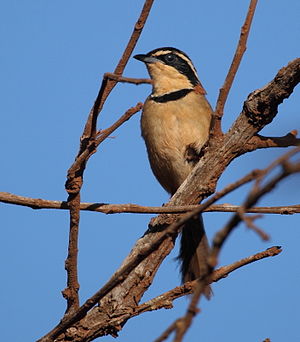Ribbon birds
| Ribbon birds | ||||||||||||
|---|---|---|---|---|---|---|---|---|---|---|---|---|

Red-necked ribbon bird ( Melanopareia torquata ) |
||||||||||||
| Systematics | ||||||||||||
|
||||||||||||
| Scientific name of the family | ||||||||||||
| Melanopareiidae | ||||||||||||
| Ericson , Olson , Irestedt , Alvarenga & Fjeldså , 2010 | ||||||||||||
| Scientific name of the genus | ||||||||||||
| Melanopareia | ||||||||||||
| L. Reichenbach , 1853 |
The bandbirds ( Melanopareia ) are a South American genus of screaming birds . Since 2009 they represent the only genus in the newly established family Melanopareiidae .
features
They are small to medium-sized soil dwellers between 13 and 16 cm in size and weighing between 16 and 23 g. The dark band on the chest, which gives the genus its name, is particularly striking. Overall, the birds have a richly contrasting plumage that is patterned brown, black and reddish brown. The species have no apparent sexual dimorphism . The general shape (stocky body, short, round wings, long legs and long, strong toes) share the band birds with their immediate relatives, such as the Bürzelstelzern .
Banded birds usually stay on the ground, where they scurry through dry bushes in search of food. Little is known about the food the birds eat.
distribution
Olive-crowned bandbird ( Melanopareia maximiliani ) and red-necked bandbird ( Melanopareia torquata ) have a fairly large distribution area that extends over central and southern Brazil , Bolivia , Paraguay and northern Argentina . The other three species have relatively small distribution areas in Peru , Bolivia and Ecuador .
Systematics
The band birds have long been part of the family of Tapaculo seen (Rhinocryptidae). However, recent studies have shown that they are not particularly closely related to these. Instead, the bandbirds occupy a basal position within the screeching birds of the "pottery bird type" (Furnariida), i. H. they are the sister group of all other birds of this type ( potter birds , ant birds , etc.).
species
- Olive-crowned bandbird ( Melanopareia maximiliani )
- Red-necked ribbon bird ( Melanopareia torquata )
- Melanopareia bitorquata (recently separated from M. torquata as a separate species)
- Schmuckband bird ( Melanopareia elegans )
- White-winged ribbon bird ( Melanopareia maranonica )
literature
- Joseph Forshaw (Ed.): Encyclopedia of Birds. Augsburg 1999, ISBN 3-8289-1557-4 .
Web links
Individual evidence
- ↑ a b N. K. Krabbe, TS Schulenberg: Family Rhinocryptidae (Tapaculos). In: Josep del Hoyo (Ed.), Andrew Elliott (Ed.), Jordi Sargatal (Ed.), David A. Christie (Ed.): Handbook of the Birds of the World. Volume 8: Broadbills to Tapaculos. Lynx Edicions, Barcelona 2003, ISBN 84-87334-50-4 , pp. 748-788.
- ↑ Per Ericson, Storrs L. Olson, Martin Irestedt, Herculano Alvarenga, Jon Fjeldså: Circumscription of a monophyletic family for the tapaculos (Aves: Rhinocryptidae): Psiloramphus in and Melanopareia out . In: Journal of Ornithology . tape 151 , no. 2 , 2010, p. 337-345 , doi : 10.1007 / s10336-009-0460-9 .
- ↑ RG Moyle, RT Chesser, RT Brumfield, JG Tello, DJ Marchese, J. Cracraft: Phylogeny and phylogenetic classification of the antbirds, ovenbirds, woodcreepers, and allies (Aves: Passeriformes: infraorder Furnariides) . In: Cladistics . tape 25 , no. 4 , 2009, p. 386-405 , doi : 10.1111 / j.1096-0031.2009.00259.x .

